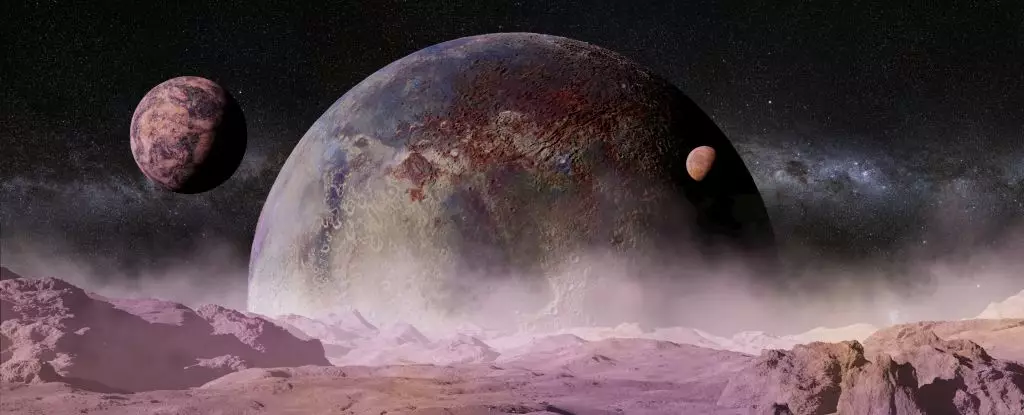For decades, humanity’s understanding of planetary systems was confined within the bounds of stars and their orbiting planets. However, recent astronomical advancements have shattered this notion, unveiling a mysterious population of free-floating, planetary-mass objects hurtling through the galaxy. These “rogue planets,” devoid of a host star, challenge our traditional conception of planetary formation and prompt a fundamental question: can such solitary wanderers nurture their own mini-systems of moons and rings? The latest insights from the James Webb Space Telescope (JWST) suggest that these objects, once considered mere cosmic debris, might be more akin to miniature solar systems than previously imagined.
The core revelation is that these rogue planets, with masses between five and ten times that of Jupiter, host complex disks composed of dusty and crystalline silicate material. This discovery indicates that, despite their solitary existence, they possess the fundamental ingredients necessary for fostering structures resembling moons or ring systems. Such findings compel us to reconsider the uniqueness of star-driven planetary formation, hinting that even worlds adrift in the darkness could potentially develop their own satellite systems — a revolutionary shift in how we interpret planetary genesis in the universe.
Crystalline Silicates and the Seeds of Moons
The JWST’s advanced infrared capabilities have illuminated the composition of these circumplanetary disks, revealing a surprising richness of crystalline silicates and dust grains. These materials are critical components in planetary and satellite formation, serving as the building blocks of rocky moons and rings. The presence of dust growth and crystallization within these disks echoes the early stages of planet formation around stars, implying a universal process that can occur independently of stellar influence.
Moreover, the detection of such materials around objects as small as a moon-sized rogue planet shifts our perspective. It suggests that the conditions necessary for moon formation—such as stable, dust-rich disks—are not exclusive to star-bound planets. Instead, they seem to be a natural consequence of planetary accretion processes, regardless of the environment. This could mean that many rogue planets are not just solitary wanderers but might host companion moons or rings, shaped over time by processes akin to those observed in our Solar System.
The Implications for Planetary and Satellite Formation Theories
These findings pose a profound challenge to existing models of planetary formation. Traditionally, the birth of planets and moons has been heavily associated with protoplanetary disks around stars. Now, evidence suggests that even worlds floating in the galactic abyss can develop their own circumplanetary disks capable of evolving complexity and potentially giving rise to moons.
If these rogue objects can indeed foster moon systems, the implications are staggering. It means the universe could be teeming with miniature, starless planetary systems—hidden, unlit worlds with their own satellite tales. Such systems would dwarf our understanding of planetary architecture, revealing a universe where planetary and satellite formation is a continuum, not an exclusive star-centric process. This discovery invites us to rethink the potential diversity of planetary systems and reevaluate the prevalence of moons and rings in environments previously deemed inhospitable.
The Significance of Discovering Moon-Forming Structures in Darkness
The notion of moons orbiting free-floating planets ignites a cascade of questions about the nature of these distant worlds. How do they capture or form their moons? Could these moons ever support conditions conducive to life, or are they inevitably barren and icy? While concrete evidence of exomoons outside our Solar System remains elusive, the JWST’s observations articulate a strong possibility that they are more common than we believe.
The idea that a moon system could exist around a starless object, evolving in silence within the cosmic dark, expands our understanding of habitability and planetary science. It opens a new frontier: the exploration of moons and rings as potential habitats, independent of traditional star-planet systems. This paradigm shift underscores that the universe’s capacity for complexity and creation extends far beyond stellar environments, leaving us with an exhilarating view of the cosmos—full of hidden worlds in motion, waiting for their stories to be uncovered.
These insights challenge the archaic view that the universe’s most intricate planetary architectures are exclusive to stars. Instead, they propel us towards a future where rogue planets are not mere cosmic anomalies but potential cradles of moon and ring systems, hinting at a universe far richer and more diverse than we have ever imagined.


Leave a Reply